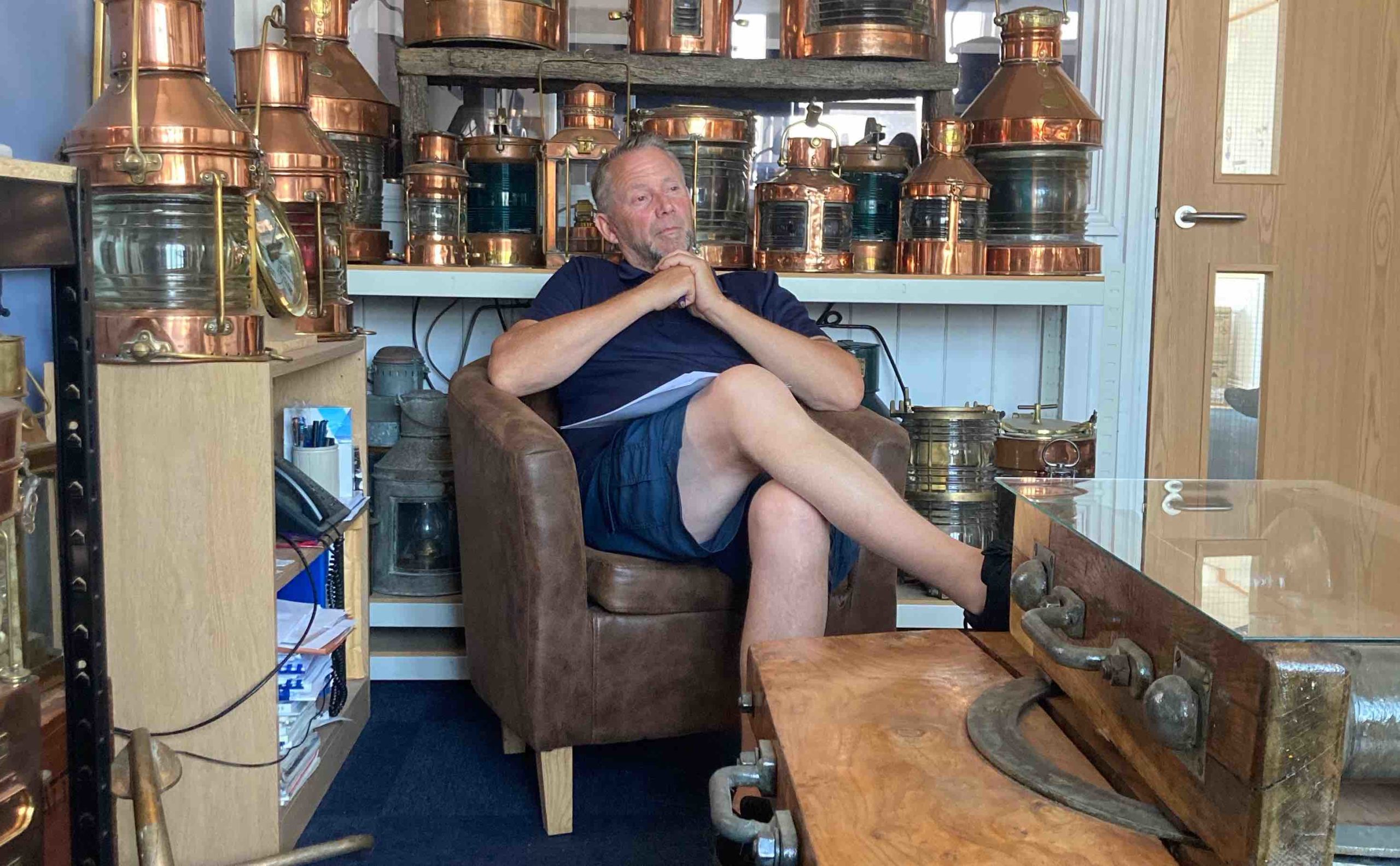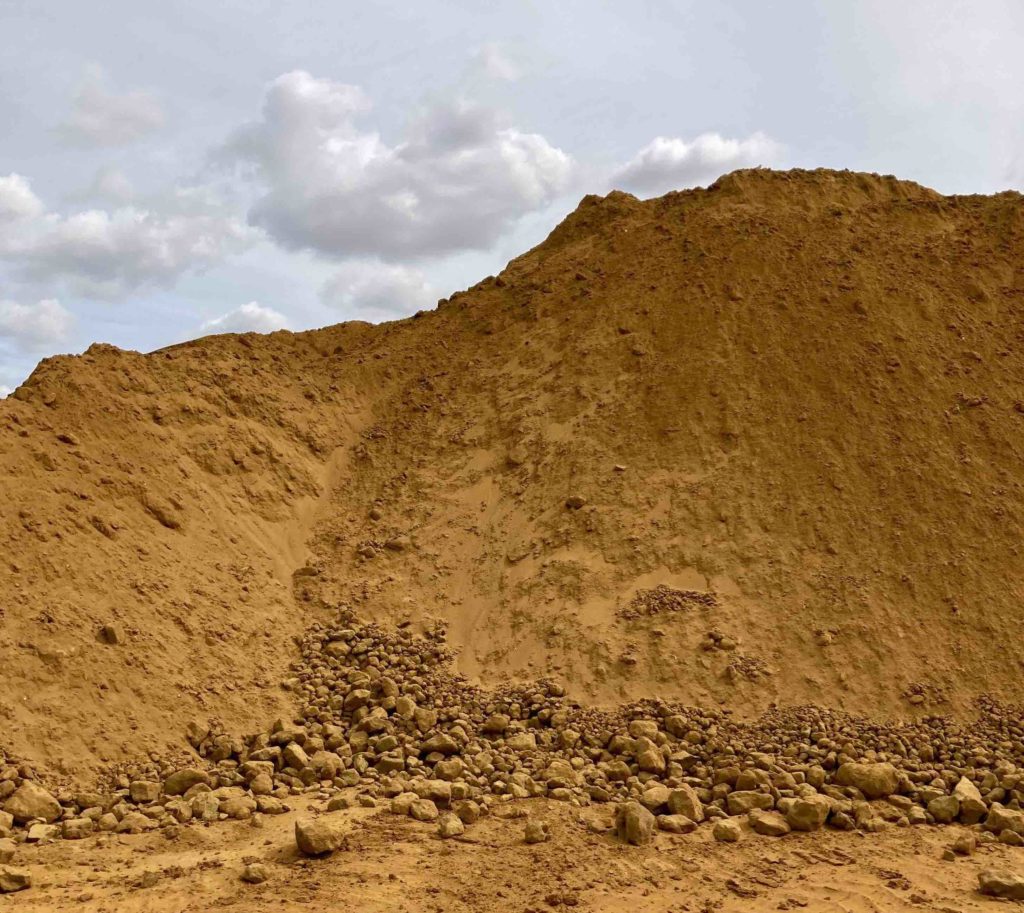Thinking about the implications of aggregate extraction, concrete production and the impact on coastal change.
Anthony Powis is a research architect currently based at University of the Arts London. He was artist in residence in summer 2022 as part of the GroundWork Gallery Extraction programme and his resultant work is in Extraction Loss and Restoration from 2 – 30 September 2022. This short essay describes some of his encounters during his residency and how these influenced the development of his thinking.
Wells, 18 July 2022


Robert Smith and Anthony Powis in conversation in Wells-next-the-sea
Sitting with Robert Smith, harbourmaster at Wells, we begin to feel not only the scale but also the inevitability of coastal change. Robert describes his certainty about what is changing——as well as his uncertainty about what we can do to deal with it.
‘We’re getting more water than we’ve ever had before, we’re getting more storms than we’re ever had before, we’re getting more surges than we’ve ever had before’
Wells Harbour Commissioners have been leading the development of a Flood Risk Management Plan, which combines local knowledge with digital hydrological modelling to propose and test flood mitigation measure.[1] Nature-based solutions such as allowing areas of freshwater marsh to flood are shown to be too slow to cope with the increased severity of tidal surges. Combine this with forecast sea level rise of a metre in the next twenty-five years, and…..
‘We can put some temporary measures in, but I think we have to realise that we’re on the coast, and maybe—as much as it hurts me to say it—we’re going to have to surrender, and let the sea take some of the coast.’
Seascapes of Extraction: off-shore dredging

I have just begun my residency at GroundWork, following stories of material movements between land and sea. My focus is on the constant tension between land- and sea-scapes that characterises this region, and the material instances of interplay between ground and water. One of these is offshore dredging for building materials: aggregates extracted from shallow banks in the North Sea, bits of used-to-be-land before the sea overtook them, and which now form part of the natural sea defences against storm surges. Dredged aggregates are used for construction projects as well as the renewal of coastal defences, and beach nourishment. Up to seven million tonnes of sand and gravel are currently extracted from the Humber region each year, most of which is shipped directly to Belgium and the Netherlands for construction. A further half–million tonnes are delivered from the English Channel to projects along the East Anglia coast.[2]
A much smaller dredger is out in port today, keeping the channel clear for boats. The coastline is ‘on the move all the time’, water full of sediment. Robert remarks that the power of nature is such that the environment can change the position of the channel overnight, but all the machinery in the world cannot keep it in one place.

Groundwater abstraction
Kings Lynn, 21 July 2022
Yesterday, on the ferry across to West Lynn, the other passengers were talking to the boatman about dredging. How regularly are they dredging the river Great Ouse, and which parts? Is it going to make it any easier to dock the small boat either side? ‘That place over there, they’ve got their own dredger, they do their little bit of the edge. They could do it for me in half an hour, but it would cost me hundreds to get someone in.’ We watch a boat going up and down and wonder its purpose.
Walking around the wash, and cycling around the rolling farmland of North Norfolk, the faint tick tack tick tack of crop sprayers irrigating fields reminds me of the inverse of aggregate dredging: the removal (abstraction) of groundwater from the chalk aquifers inland in order to irrigate agricultural land.
I am in England’s driest county, in a drought, in record temperatures that are igniting nearby reserves, and suddenly water hits me in the face, spraying onto the road as I pass by a field.

‘Erosion and deposition are what the sea does’
Cley and Salthouse, 22 July 2022
‘Is nature conservation about preservation? The first thing you learn is that everything changes.’
A week into my residency, I am thinking more and more about edges: sea-defences, cuts, shingle banks, trenches, offshore sandbanks. All these constitute the infrastructure that exists or is designed to protect and differentiate different parts of land and sea.
Large-scale land reclamation began in the seventeenth century, with the construction of drains to eject water from what was once marshland, and dykes to withhold the intrusion of seawater. But these boundaries keep being breached, and need to be built ever higher. That world—breached—is also used in law, to describe a failure to observe or abide by a supposed behaviour. Nature fails to observe boundaries and borders.

‘That’s what makes conservation so tricky: because you’re dealing with completely linked systems. It’s no good trying to isolate something and put a fence around it, protecting that one little bit.’
These are themes that I pick up on a dreamy walk around Cley and Salthouse Marshes with David North, formerly Head of People and Wildlife at Norfolk Wildlife Trust. We start talking about climate depression: how we individually cope with working in the fields of climate change, biodiversity loss, and threats to habitats. I suggest that when one is in a place like this, with its beauty and tranquillity, it is easy to think that everything is working fine, that natural systems are working fine. David corrects me: ‘There’s almost nothing natural about this site’. The wetland reserve is highly managed: an attempt to somehow compensate for the massive reduction in area of wetland habitat that has happened here in the past few centuries.
David’s particular skill seems to be in linking what he sees to a wider system: in thinking like a bird, thinking about interconnection rather than isolation. He points out to me species that have just arrived from the Arctic, or are on their way to Africa. There are even birds making regular flights to Spain and back to collect food for their young, as declining insect populations mean there is not enough food locally. For a bird, this site is one point in a network of relations—a network that includes atmospheric, marine, animal, and telluric processes. He gets annoyed when people complain about erosion. Erosion and deposition are what the sea does, parts of a process. One of the problems, he says, is that ‘we’re good at learning about nature, and bad at living with it’.
Seascapes of Extraction: changing the understanding of the coast
GroundWork Gallery, 23 July 2022
During my open day back in the gallery, I am thinking about how these and other explorations/conversations are already starting to change my understanding of the coastline. The coast is a place of both plenty and fragility, movement and threat. Whilst the aggregate industries capitalise the terrestrial elements of the seascape—sand and gravel—agricultural industries capitalise groundwater from beneath reclaimed land. But this is much more than a reciprocal process of exchange between land and sea: the incommensurability of the many interconnected processes just reinforces how every intervention in this systems carries consequences.
How would I describe, say, a sandbank, thinking not in terms of what it is, but in terms of interconnection—thinking like a bird and seeing the sandbank as a network of relations rather than a thing. It would be not only geology, but also (to some) a material asset, something that could be about to become the next megastructure on the agenda of an international construction boom, or a marine reserve, awash with species and habitats, a resting place in a shallow sea, or a line of defence, the only thing between Wells harbour and the North Pole, that could take the energy out of a tidal surge with bad timing.

Blackborough End and Nar Valley, 28 July 2022
Transient landscapes of extraction
Before I leave, I get the chance to meet Peter Lemon at Middleton Aggregates, who shows me around some current and former quarrying sites. Quarrying is transient, it’s about change, and Peter thinks about the landscape in cycles: what it was, what he’s doing with it, and what it will become afterwards. We see pits in various states from active carstone quarrying to almost dune-like landscapes full with plants I recognise from visits to Holme Dunes and other nearby reserves. Alongside are stocks of recycled materials: concrete, brick, and asphalt, as well as broken mugs from a nearby factory. Inert landfill of soil and building materials is capped with a geological barrier. Another area which is no longer being dug has been restored to rare acid grassland habitat. A hill is criss-crossed with black pipes capturing methane from decomposing waste, for use in energy generation.
At nearby Pentney, in the Nar Valley, there is a larger operation extracting sands and gravels from the former river bed. Until the improvement, or canalisation, of the river Nar in the 1920s, Peter tells me, much of this area was floodplain, and it carries several millennia of artefact. We find shards of mammoth tusk in a pile of ungraded gravel.

Extraction landscapes and the importance of scale
Clay is also extracted nearby, used in flood defence works, and in the on-site construction of bank and lakes: part of the after-use as a fishing and boating lake. It’s easy to dismiss quarries as part of the extractivist mode of production: excessive and degenerative. But Peter speaks like an ecologist, with great care for the land, always thinking of its eventual return, and of after-uses. ‘All quarries run out’, and this is part of his thinking. He laments the reduction in number of smaller quarrying operations like his, and the consolidation of quarrying by larger companies, who control the ready-mix concrete industry and feed large-scale construction.
I do, too, as I think about what happens when extraction moves from sites like this—highly controlled, visible, populated, cared-for—to the offshore, unseen, less planned, and where we only see the effects when it is too late.

[1] https://www.portofwells.co.uk/wp-content/uploads/2021/02/Port-of-Wells-Flood-Risk-Management-v3-1.pdf
[2] https://www.thecrownestate.co.uk/media/4097/2022-summary-statistics.pdf



